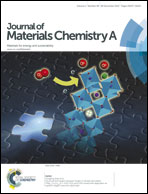In situ polymerization of mechanically reinforced, thermally healable graphene oxide/polyurethane composites based on Diels–Alder chemistry
Abstract
Covalently bonded graphene oxide/polyurethane (GO/PU) composites with significant reinforcement and thermally healable properties were developed via in situ polymerization based on Diels–Alder (DA) chemistry. The PU prepolymer was prepared with GO, 4,4-diphenylmethane diisocyanate, and poly(tetramethylene glycol) and blocked by using furfuryl alcohol firstly. Then the prepolymer was cross-linked by using bifunctional maleimide via DA chemistry. SEM shows that the GO was dispersed uniformly in the PU matrix. The DA and retro-DA reactions were characterized by Fourier transform infrared spectroscopy and differential scanning calorimetry separately. Tensile tests showed that with the incorporation of 0.1 wt% of GO, the tensile modulus of GO/PU composites increased from 9.80 MPa to 21.95 MPa, and the tensile strength and elongation at break of the GO/PU composites increased by more than 367% and 210%, respectively. Furthermore, the composites had thermally healable ability which was inspected by using an atomic force microscope and the strain–stress test. The healing efficiency of 78% on average was achieved which was determined by the recovery of breaking stress and a healing mechanism was tentatively proposed. Therefore, the covalently bonded self-healing GO/PU composites could be used as smart materials and structural materials.


 Please wait while we load your content...
Please wait while we load your content...